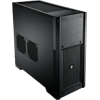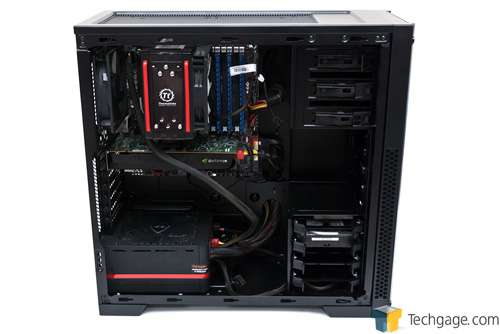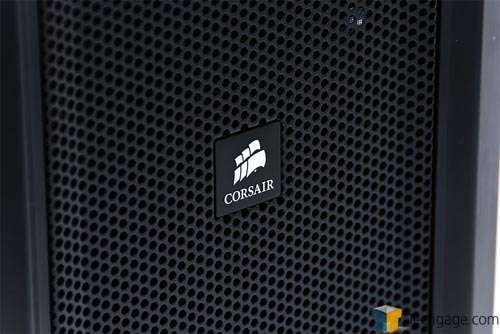- Qualcomm Launches Snapdragon 4 Gen 2 Mobile Platform
- AMD Launches Ryzen PRO 7000 Series Mobile & Desktop Platform
- Intel Launches Sleek Single-Slot Arc Pro A60 Workstation Graphics Card
- NVIDIA Announces Latest Ada Lovelace Additions: GeForce RTX 4060 Ti & RTX 4060
- Maxon Redshift With AMD Radeon GPU Rendering Support Now Available
Corsair Carbide 300R Mid-Tower Gaming Chassis Review

In a market with over a billion (give or take a couple) different chassis for under $100, finding the “right one” is easier said than done. Fortunately, there are some vendors where you pretty-well know by default that their product won’t let you down. Corsair is one of those, and we’re here to see if its Carbide 300R lives up to those high expectations.
Page 3 – Installation & Final Thoughts
Unlike Ryan’s chassis reviews, where many comparisons are made and temperature testing is conducted, I’m unable to do any of that for the 300R. The reason is twofold; I have no comparison data, and this chassis arrived at a perfect time given my brother’s PC was in bad need of a chassis replacement. Thus, all of the parts installed in the shot below are his own, rather than our usual testing equipment.
With the chassis and all of the components laid out, I’d guesstimate that the entire install took me about an hour – 20 minutes of which were dedicated to slight confusion and minor trouble-shooting. Let me explain.
On the previous page, I talked a bit about the gold standoff in the center of the chassis, but what I didn’t mention is that the rest of the standoffs are built right in, thanks to indented spots. However, there was no standoff, indented or not, in the location I needed for the bottom of the mATX motherboard I installed. Ordinarily, this isn’t an issue as you can simply install another standoff, but it’s only simple if the chassis actually includes that standoff. As you can guess, the 300R doesn’t.
It’s not a major issue to leave one single hole empty, but it’s not ideal either. It would cost Corsair literally nothing to toss in just one extra standoff for those with mATX motherboards, and though a small issue, I’d love to see this addressed in the future.
As you can see in the shot above, the wiring is kept very clean, and this is certainly not on account of my attention to detail. Thanks to the cable routing holes, which Corsair seemed to really make popular on its 800D, you’re able to store most of the cabling in the back of the motherboard tray, out of sight. With all of the cabling seen in the image here, I didn’t have any problem putting the chassis door back on, and it doesn’t buldge (a problem that drives me batty).
Overall though, the installation was smooth, and would have been perfect if I had installed an ATX motherboard (but at the same time I wouldn’t have noticed the issue with the standoff). Though the chassis is being left-is for now, with no additional fans installed, it offers rather good airflow thanks to the totally unblocked 140mm fan in the front. Airflow will only be improved if you want to install some fans at the top and side, which I heavily recommend if your components wind up being a little cramped, and / or you have dual graphics cards installed. As a whole, the components in our build are somewhat modest, else additional fans would seem more necessary.
Compared to the behomoth Obsidian 800D chassis I use for my personal rig, the 300R isn’t quite as sturdy, but it’s the best-built sub-$100 chassis I’ve ever laid my hands on. While it launched at $90, it now regularly retails for $80, which definitely opens the doors for those who want a great chassis but don’t want to spend too much. Though numerous fans aren’t expected on a chassis of this price-point, I do recommend adding some to the top if you have a beefier rig. This applies to any chassis, not just this one.
If I were in the market for a sub-$100 chassis, the 300R would easily be among my considerations. Corsair has long offered chassis that have struck my aesthetic fancy, and the attention to detail and internal design definitely help make this the complete package. It is truly unfortunate that there’s no USB 3.0 to 2.0 internal cable included, so hopefully that means you won’t need one for your own build, as adding $5 for the accessory box isn’t great.
When all said in done, yet another Corsair chassis has earned our Editor’s Choice award. The 300R offers a great blend of design, aesthetics, functionality and other niceties (such as dual dust filters and many cable routing holes), making it well worth consideration for your next PC.
Pros
- Excellent build quality for its price-point.
- Option to add five additional 120/140mm fans.
- Extremely easy to work with; front detaches easily for ODD installation.
- Proper drive holders for internal HDDs / SSDs.
- Removable dust filters at the bottom and front.
- Huge opening in the motherboard tray for installing CPU coolers after the board is installed.
- Cable routing system helps you look like a pro builder.
Cons
- Those without an internal USB 3.0 header will need a conversion cable for front panel USB ports.
- mATX users will need their own motherboard standoff.

Corsair Carbide 300R Mid-Tower Chassis
Discuss this article in our forums!
Have a comment you wish to make on this article? Recommendations? Criticism? Feel free to head over to our related thread and put your words to our virtual paper! There is no requirement to register in order to respond to these threads, but it sure doesn’t hurt!
Support our efforts! With ad revenue at an all-time low for written websites, we're relying more than ever on reader support to help us continue putting so much effort into this type of content. You can support us by becoming a Patron, or by using our Amazon shopping affiliate links listed through our articles. Thanks for your support!







